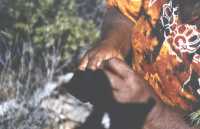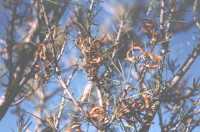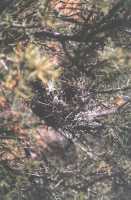Kurara or Dead Finish (Acacia
tetragonaphylla)is a distinctive shrub with small four sided needle-like phyllodes
(leaves) and yellow spherical flower heads. It is common and widespread in breakaway and
sandhill country of the arid zone. Dead Finish has gnarled and twisted wood, and grows to
three metres. Like the Mulga, Kurara is a very useful
plant, and due to it being common in the area, is also an important plant in Antakarinja culture.
The bark from the roots of this plant has
healing qualities. It is used as a bandage to bind broken limbs, with the straight roots
as splints, repairing the bone quickly. The healing of minor cuts and sores can be
encouraged by the application of a liquid made by boiling this bark in water. A medicine
to treat coughs is also made by soaking the roots and bark.

Eileen Crombie treating a wart with Kurara
needles
Kurara also provides an excellent method of removing unwanted warts. Dry
phyllodes from the ground beneath the plant are collected and stuck into all sides and the
top of the wart. The ends are broken off and the tips are left in for two to three days,
by which time the wart should have died and dropped off.

Kurara seed pods
Dead Finish also provides some important
bush tucker. The seeds can be cooked in the pod when still green, or when ripe, parched on
hot sand and ashes, yandyed, and ground to form an edible paste.
Grubs that can be found in the roots of
this plant also provide a tasty meal. Finches, nesting in the protective foliage of Kurara,
are eaten, while droppings from abandoned nests have important medicinal properties.

Zebra Finch nest
The hard, fine-grained wood of Dead Finish
also makes good artefacts and tools. |